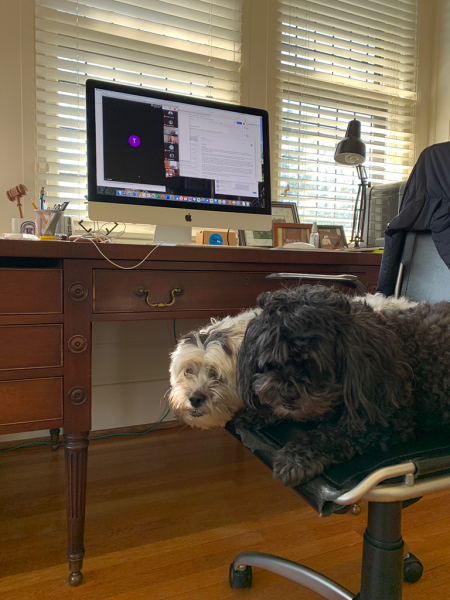The Power of Unintentional Community

Every working-style assessment I have done highlights one of the defining features of my personality: I am an introvert. (Last summer, participating in such an exercise with Kenyon’s senior leadership team, my introvert score was nearly off the scale.) I often am asked about how my introvert status matches with my chosen profession. As a college president, I spend most, if not all, of my professional time with other people. Meetings typically fill my entire day, and my nights often include dinners for visiting speakers, receptions with alumni or parents, events in the community and more. Life in Gambier, too, features a constant hum of connections and conversations as I walk my dogs, exercise in the KAC or drop by the post office or the bookstore. The president of Kenyon is rarely alone.
How does an extreme introvert cope from day to day? Primarily by following advice laid out in work such as Susan Cain’s book “Quiet”: finding moments for myself, building time into the day to restore my energy after a long stretch of engagement, and keeping to a structured routine.
Enter the new world of physical distancing in which we now live. I must confess, my first thought was that this is a moment made for introverts. (Indeed, I began to plot what I would do with all of the extra energy I’d have — perhaps I’d get a good start on some long-planned writing projects.) I was not alone in this line of thinking — writers in The Atlantic, Psychology Today and other publications began to ponder whether this was “Springtime for Introverts.”
But here we are, more than two weeks into Ohio’s “stay at home” order (recently extended through May 1), and I’ve yet to feel any expected energy infusion. Instead, I am struck by a powerful sense of loneliness on campus. My family is here, of course, as are our dogs Skittles and Roo (pictured above, charmingly and reassuringly unaware of the changes going on in the world, beyond the fact that the humans seem to be in the house much more than usual). And in-person meetings have largely been replaced with phone and video meetings, so my day is still tightly scheduled. But I miss the daily face-to-face interactions with people. I miss the nods, waves and hellos exchanged on Middle Path; the conversations in the bookstore as I pick up the daily newspaper; the chance to talk with colleagues in my office not in a scheduled Zoom meeting, but in the moment-by-moment check-ins where we share news about our families, our lives away from Ransom Hall, the shared sadness of the most recent (or any) episode of “This is Us.” (Pearson family drama is just not the same if I do not talk about it with someone the next morning.)
Research shows that human connection is essential to happiness, and that small, daily connections matter a great deal. Yale Professor of Psychology Laurie Santos addresses this in an episode of her podcast The Happiness Lab titled “Mistakenly Seeking Solitude”: Regular moments of human contact — casual interactions while walking, riding a bus, standing in line — all contribute to our level of happiness, and when they are limited, our well-being suffers.
All of us at Kenyon are guilty of overusing the word “community,” which we invest with a great deal of meaning and importance. But let’s, for a moment, reduce this word to its simplest meaning: a group of people living in the same place. The current crisis reminds us that the very act of gathering — here in Gambier, here in one place — holds simple but important power. We build the Kenyon community in our classrooms, through athletics, through the arts, through shared experiences of all types. Much of this intentional community-building now continues at a distance, as classes continue to meet, as student organizations find ways to stay active while separated, as arts groups find creative outlets online.
Yet as we celebrate the intentional community built at Kenyon, we should not lose sight of the power of the unintentional, casual community generated here: the banter before and after class; the conversations among dog-walkers (and with students who love dogs); the recapping of every Browns defeat (and the occasional Browns victory) at the Gambier Deli; and perhaps what I miss the most, the passing smiles and waves on Middle Path. We may not give much thought to these connections during our time together on campus — indeed, while important, these ordinary encounters may fade into the backdrops of our daily lives. But I find that in these extraordinary times, these are the interactions I crave most.
As an introvert, I sometimes need solitude in order to recharge. The current environment reminds me that I also have come to rely upon a recharge from the Kenyon community. I look forward to our full return to the Hill — but until then, even as we’re far from Kokosing, we can keep our Kenyon spirit alive through emails, phone calls, social media, even letters (we are, after all, a writer’s college). Things are not “business as usual,” so let’s make time for exchanges that aren’t strictly business, for those smaller moments of humanity that fortify our souls.
